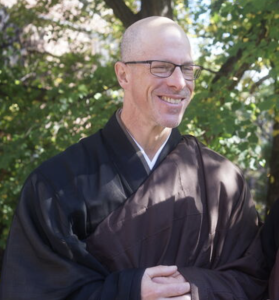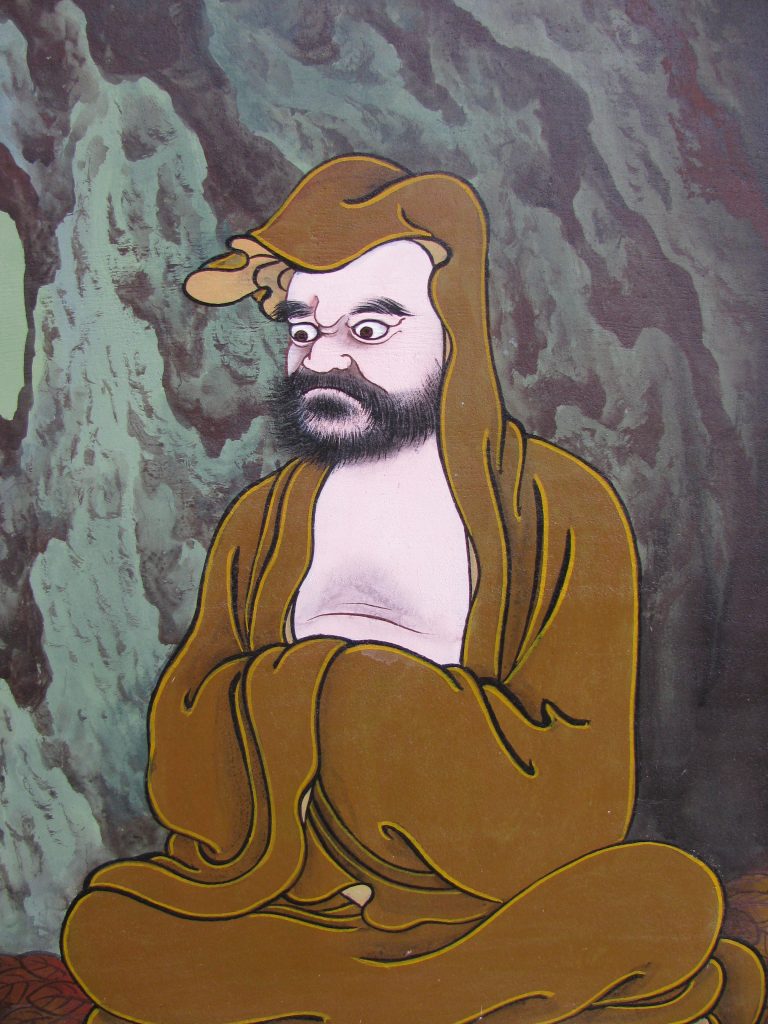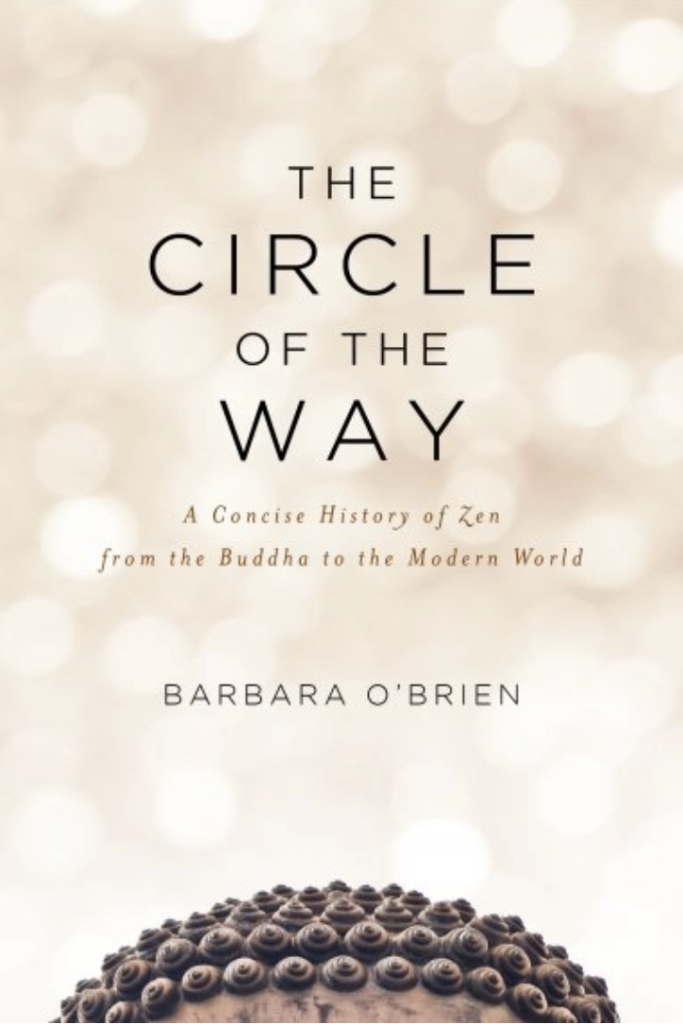How might exploring Zen’s myths and complex history fortify our practice?
August 27, 2025

An interview with Charlie Korin Pokorny on his upcoming Zen history class
This fall Charlie Sensei is offering a new online class, “ZEN! History, Teachings, Practices” at Brooklyn Zen Center. We spoke with him about how understanding Zen’s complex history—both its myths and scholarly findings—can deepen our practice by honoring ancestors and strengthening our relationship with the tradition.
What might students walk away with that surprises them?
One thing that might be surprising, and potentially challenging, is how Zen has often been very much involved in creating a history of itself. For example, Bodhidharma is revered for bringing Zen from India to China. This is completely myth. While not literally true, myths can hold important truths. Grasping a myth as literal truth can obscure very important aspects of how Zen did in fact arise. I’m interested in a middle way that embraces Bodhidharma as mythological ancestor, and also embraces the matrix of Chinese Buddhism in the 5th – 8th centuries as the more historical “ancestor” of Zen.
Other surprises might include: if people are familiar with how Soto and Rinzai Zen differ, they may be surprised to see how they both spring from a shared paradigm of radical buddha-nature. For a few centuries, Zen writings had very little in the way of meditation instruction. D.T. Suzuki’s writings, which were pivotal in introducing Zen to the U.S., were profoundly influenced by Western thought, especially William James. And while Zen koans embody something of a radical innovation in Buddhist literature, they share some key features with narratives in the Pali canon of the Theravada school.
What’s the biggest misconception students bring about Zen history?
To my mind, the biggest misconception may be that Zen is not like other forms of Buddhism in East Asia, that it was, as it sometimes claimed, a special transmission. I’m in favor of locating Zen as simply one among many when it comes to the Buddhist traditions of East Asia.
When I stop focusing on differences, I can appreciate similarities, and also open to mutually enriching conversation across traditions. I think Zen practitioners have much more to gain than to lose in developing relationship and connection with other forms of Buddhist practice and teaching, as well as non-Buddhist.
Can you share some stories that are part of the course or give people an idea of what these stories are like?
Blue Cliff Record Case 86: Yun Men imparted some words saying, “Everyone has a light; when you look at it, you don’t see it and it’s dark and dim. What is everybody’s light?”
The basic premise of Chan or Zen is a radical affirmation of buddha-nature. Yunmen’s words invoke this premise, “Everyone has a light.” And then he points to how this light or buddha-nature is beyond knowing and grasping, “when you look at it, you don’t see it and it’s dark and dim.” He concludes with an inquiry, “What is everybody’s light?” Zen is inquiring into the practice and realization, life and expression of this light or buddha-nature. Over time, some different approaches develop in speaking to how this inquiry unfolds, and still, these divergent forms of Zen share this vital inquiry into how buddha-nature lives in practice.
Transmission of Light Case 2: When the World-Honored One held up a flower and blinked his eyes, Mahakāśyapa cracked a slight smile. The World-Honored One said, “I have the treasury of the true dharma eye, the sublime mind of nirvāna, which I entrust to Mahākāśyapa.”
This is a mythological creation of the Zen tradition in China. It’s not a historical event, and as a teaching and encapsulation of Zen practice, it carries great significance. In short, Zen emphasizes that awakening lives in dialogue and meeting, person-to-person, face-to-face, heart-mind to heart-mind. This story encapsulates Zen’s re-creation of Buddhism.
You mentioned some compelling images—a Bodhidharma painting you photographed in Korea and Hakuin’s Bodhidharma works. What makes these compelling for exploring Zen history?
Bodhidharma is a key symbol of Zen. All Zen traditions honor Bodhidharma as a key founder as it is said that he brought Zen from India to China. Bodhidharma embodies an unbroken continuity of awakening between Sakyamuni Buddha and Zen lineages. It is also said that he sat facing the wall of a cave for nine years. When we sit facing the wall in Soto Zen, we enact and connect to this.

How did your path into both Zen practice and scholarship develop?
I deeply appreciate a conversation between devoted Zen practice and academic scholarship. While scholarship sometimes produces findings that are difficult or challenging for practitioners, I appreciate the devotion, diligence and brilliance academics bring to the study of this tradition that I love. Where the Zen tradition may be found to be all-too-human, I appreciate the humility in coming back down to the earth. While Zen may then lose some of its pretenses of being an exceptional tradition of Buddhism, “a separate transmission outside the teachings,” opening to how Zen is enmeshed in a bigger picture of the traditions and currents of East Asian Buddhism offers a more expansive ocean of ancestors, heritage and sense of connection across schools and lineages.
While your class may illuminate how Zen is simply one among many East Asian Buddhist traditions, what is something particular that Zen offers within this rich history of traditions?
Zen is based on a radical approach to buddha-nature. A conservative approach may be like seeing buddha-nature as a seed—a potential which can be brought to fruit through careful cultivation of many conditions over many, many years. We find formulations such as the six paramitas of giving, ethics, patience, enthusiasm, meditation and wisdom, which need to be cultivated for many billions of eons for a bodhisattva to become a buddha.
A radical approach sees buddha-nature as a jewel that is already perfect. Practice is then less about assembling conditions conducive to the growth of a seed, and more about either seeing the jewel, or bringing out the jewel. While classic Zen tends to emphasize a radical approach, I think that both are true, and can be integrated in various ways.

How do you balance mythological narratives with academic findings?
Zen has been deeply involved in creating a mythological history of itself. If I’m grasping a myth as history, seeing that the myth is truly not literal can be experienced as disappointing or discouraging. However, when a myth is just a myth, it can hold layers of meaning that literal history may not hold so well. And, opening to the literal history can allow me to embrace unrecognized ancestors of Zen.
What would you tell someone who’s practicing but wonders if they “need” the historical context?
First, I see this as a way of honoring ancestors and being in relationship with the tradition. On one hand, there is “the light of the self,” which is vital in how we illumine the path. On the other hand, there is “the light of the dharma,” which is no less vital. I feel a deep responsibility to actualize a practice together that is authentic to who we are, and that also respects and honors our lineage and tradition.
Second, I think it can be very helpful to have clear chronological and geographical frameworks to contextualize or locate Zen stories and teachings. This can deepen understanding.
Third, Zen holds a rich, deep ocean of teachings, stories and practices. There is so much to appreciate and be inspired by. “Dharma gates are boundless, I vow to enter them.”
ZEN! History, Teachings, Practices runs for 10 sessions, Tuesdays September 23 through November 25, 7:00–8:30 PM ET online. Registration ends September 21. Pricing requests are due September 14.
For more information and registration, click here.